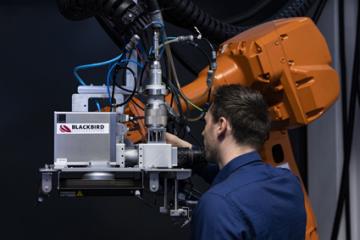Scan Head with Beam Shaper Increases Fuel Cell Production Throughput

Puchheim, Germany – SCANLAB GmbH, in collaboration with its sister companies Blackbird Robotersysteme GmbH and Holo/Or Ltd, is developing exciting new system concepts for laser applications such as laser welding of bipolar plates and additive manufacturing (metal 3D printing). The novel scan arrangement demonstrated the ability to nearly double the productivity of welding bipolar plates for hydrogen fuel cells by incorporating tailored beam shapers.
For a long time, fuel cell technology was seen as a niche market. The market demand may increase significantly as a result of the transition phase in energy generation and the search for alternative drives. Increased throughput in welding of metal bipolar plates, which are used to create the stacks in a fuel cell, is required for efficient mass production. Fast scan systems and high-power lasers, both of which are available, are required for high welding speeds. However, the maximum reachable speed is determined by the welding process itself. When a particular speed limit is exceeded, weld seam failures such as humping effects and undercut occur.
Blackbird Robotersysteme set up a test rig integrating the SCANLAB’s 2D scan head intelliSCAN and HOLO/OR’s latest development, the Flexishaper, a full range adjustable beam shaper. Welding process simulations were used to determine the required beam shape. The layout of the utilized beam shaper is the result of a combined optical design that incorporates both diffractive optical elements (DOE) and a scan system. The processing tests revealed that the speed limit of failure free welding speed may be increased from 45 m/min to 70 m/min.
Adopting DOEs processing experience
Thin sheet welding of bipolar plates has needs similar to laser powder bed fusion (LPBF) processes. Both require scan field sizes of up to 500 × 500 mm² and processing speeds of 1m/s or less. Also, with metal 3D printing, the processing speed is not limited by the speed of the scanner or the available laser power, but rather by the process itself. As a result, the encouraging laser welding results constitute the initial step toward further optimizing LPBF operations.
The next step will be to test the laser welding concept on a wider scale and to pursue multiple applications concurrently. As the fiberSYS fits the criteria of both LPBF and laser welding processes, the integration of DOEs into this scan system, which is especially well-suited for multi-head laser machines, was included in the development roadmap.
Georg Hofner, CEO SCANLAB, commented, “Our joint company holding creates the trust that is necessary for such a close cooperation to explore innovative solutions. Only in a setup like this you can openly analyze the upcoming market requirements and transfer the outcome in an optical design.”
To this, Karl Christian Messer, CEO, Blackbird Robotersysteme, added, “Our sister companies provide a construction kit for us, which we can translate into tangible benefits for our markets and customers based on our specific experience and application knowledge.”
Against this backdrop, Israel Grossinger, Owner and President, HOLO/OR, concluded,“This is exactly the kind of cooperation that creates high value products by combining our unique beam shaping expertise with our sister companies’ market deep understanding.”
Image Source: SCANLAB GmbH



 Facebook
Facebook.png) Twitter
Twitter Linkedin
Linkedin Subscribe
Subscribe